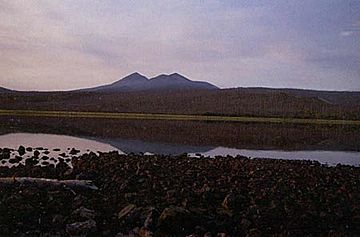Volcano Mountain facts for kids
Quick facts for kids Volcano Mountain |
|
|---|---|
 |
|
| Highest point | |
| Elevation | 1,239 m (4,065 ft) |
| Geography | |
| Location | Yukon, Canada |
| Parent range | Yukon Ranges |
| Topo map | NTS 115.I/14 |
| Geology | |
| Age of rock | Holocene? |
| Mountain type | Cinder cone |
| Volcanic arc/belt | Northern Cordilleran Volcanic Province |
Volcano Mountain is a special type of cinder cone volcano. It is located in the central Yukon Territory, Canada. You can find it north of Fort Selkirk, where the Pelly and Yukon Rivers meet. The local Northern Tutchone people call Volcano Mountain Nelrúna.
All About Volcano Mountain
Volcano Mountain is a "cinder cone." This means it's a cone-shaped hill. It's built from small pieces of volcanic rock. These pieces are called cinders. They erupt from a single opening in the ground.
How Volcano Mountain Formed
Volcano Mountain is the newest volcano in its area. This area is called the Fort Selkirk volcanic field. It is also one of the youngest volcanoes in the northern part of the Northern Cordilleran Volcanic Province. The lava that came from Volcano Mountain is a rare type. It is called olivine nephelinite. Scientists believe this kind of lava comes from very deep inside the Earth. It comes from much deeper than common lava like basalt.
What to Watch Out For
If Volcano Mountain erupts again, it would likely produce lava flows. These are streams of hot, melted rock. There probably wouldn't be much ash or rock thrown into the air. The main dangers from a future eruption would be forest fires. These fires could start if the hot lava flows touch trees. Poisonous gases could also be released.
Long ago, older lava flows from this area partly blocked the Yukon River and Pelly Rivers. This changed where the rivers flowed. If Volcano Mountain becomes active again, it could affect these big rivers. This might cause problems for people living or working downstream.

